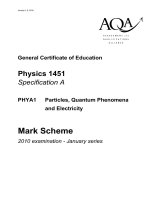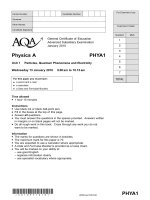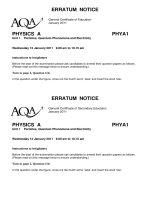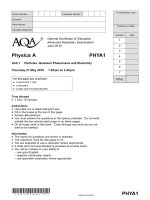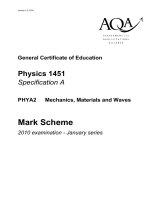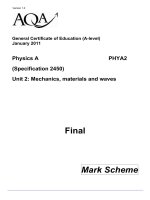- Trang chủ >>
- Khoa Học Tự Nhiên >>
- Vật lý
Vật lý A level: AQA PHYA52B w MS JUN12
Bạn đang xem bản rút gọn của tài liệu. Xem và tải ngay bản đầy đủ của tài liệu tại đây (412.64 KB, 11 trang )
Version 1.0
General Certificate of Education (A-level)
June 2012
Physics A
(Specification 2450)
PHYA5/2B
Unit 5/2B: Medical Physics
Final
Mark Scheme
Mark schemes are prepared by the Principal Examiner and considered, together with the relevant
questions, by a panel of subject teachers. This mark scheme includes any amendments made at the
standardisation events which all examiners participate in and is the scheme which was used by them
in this examination. The standardisation process ensures that the mark scheme covers the
candidates’ responses to questions and that every examiner understands and applies it in the same
correct way. As preparation for standardisation each examiner analyses a number of candidates’
scripts: alternative answers not already covered by the mark scheme are discussed and legislated for.
If, after the standardisation process, examiners encounter unusual answers which have not been
raised they are required to refer these to the Principal Examiner.
It must be stressed that a mark scheme is a working document, in many cases further developed and
expanded on the basis of candidates’ reactions to a particular paper. Assumptions about future mark
schemes on the basis of one year’s document should be avoided; whilst the guiding principles of
assessment remain constant, details will change, depending on the content of a particular examination
paper.
Further copies of this Mark Scheme are available from: aqa.org.uk
Copyright © 2012 AQA and its licensors. All rights reserved.
Copyright
AQA retains the copyright on all its publications. However, registered centres for AQA are permitted to copy material from this
booklet for their own internal use, with the following important exception: AQA cannot give permission to centres to photocopy
any material that is acknowledged to a third party even for internal use within the centre.
Set and published by the Assessment and Qualifications Alliance.
The Assessment and Qualifications Alliance (AQA) is a company limited by guarantee registered in England and Wales (company number 3644723) and a registered
charity (registered charity number 1073334).
Registered address: AQA, Devas Street, Manchester M15 6EX.
Mark Scheme – General Certificate of Education (A-level) Physics A – PHYA5/2B – June 2012
3
Instructions to Examiners
1 Give due credit for alternative treatments which are correct. Give marks for what is correct in
accordance with the mark scheme; do not deduct marks because the attempt falls short of
some ideal answer. Where marks are to be deducted for particular errors, specific instructions
are given in the marking scheme.
2 Do not deduct marks for poor written communication. Refer the scripts to the Awards meeting
if poor presentation forbids a proper assessment. In each paper, candidates are assessed on
their quality of written communication (QWC) in designated questions (or part-questions) that
require explanations or descriptions. The criteria for the award of marks on each such
question are set out in the mark scheme in three bands in the following format. The descriptor
for each band sets out the expected level of the quality of written communication of physics for
each band. Such quality covers the scope (eg relevance, correctness), sequence and
presentation of the answer. Amplification of the level of physics expected in a good answer is
set out in the last row of the table. To arrive at the mark for a candidate, their work should first
be assessed holistically (ie in terms of scope, sequence and presentation) to determine which
band is appropriate then in terms of the degree to which the candidate’s work meets the
expected level for the band.
QWC
descriptor
mark range
Good - Excellent
see specific mark scheme
5-6
Modest - Adequate
see specific mark scheme
3-4
Poor - Limited
see specific mark scheme
1-2
The description and/or explanation expected in a good answer should include a
coherent account of the following points:
see specific mark scheme
Answers given as bullet points should be considered in the above terms. Such answers
without an ‘overview’ paragraph in the answer would be unlikely to score in the top band.
3 An arithmetical error in an answer will cause the candidate to lose one mark and should be
annotated AE if possible. The candidate’s incorrect value should be carried through all
subsequent calculations for the question and, if there are no subsequent errors, the candidate
can score all remaining marks.
4 The use of significant figures is tested once on each paper in a designated question or part-
question. The numerical answer on the designated question should be given to the same
number of significant figures as there are in the data given in the question or to one more than
this number. All other numerical answers should not be considered in terms of significant
figures.
5 Numerical answers presented in non-standard form are undesirable but should not be
penalised. Arithmetical errors by candidates resulting from use of non-standard form in a
candidate’s working should be penalised as in point 3 above. Incorrect numerical prefixes and
the use of a given diameter in a geometrical formula as the radius should be treated as
arithmetical errors.
6 Knowledge of units is tested on designated questions or parts of questions in each a paper.
On each such question or part-question, unless otherwise stated in the mark scheme, the
mark scheme will show a mark to be awarded for the numerical value of the answer and a
further mark for the correct unit. No penalties are imposed for incorrect or omitted units at
intermediate stages in a calculation or at the final stage of a non-designated ‘unit’ question.
7 All other procedures including recording of marks and dealing with missing parts of answers
will be clarified in the standardising procedures.
Mark Scheme – General Certificate of Education (A-level) Physics A – PHYA5/2B – June 2012
4
GCE Physics, Specification A, PHYA5/1, Nuclear and Thermal Physics
1
a
2
17 K
1
b
2
t = 15 s
2
a
) + + Pb X(
e
0
1-
206
82
206
76
1
β = 6
2
b
i
the energy required to split up the nucleus
2
into its individual neutrons and protons/nucleons
(or the energy released to form/hold the nucleus
from its individual neutrons and protons/nucleons )
2
b
ii
7.88 206 = 1620 MeV (allow 1600-1640 MeV)
1
2
c
i
U, a graph starting at 3 10
22
showing exponential fall passing
through
2
0.75 10
22
near 9 10
9
years
Pb, inverted graph of the above so that the graphs cross
at 1.5 10
22
near 4.5 10
9
years
2
c
ii
(u represents the number of uranium atoms then)
1
2
103
22
u
u
u = 6 10
22
– 2u
u = 2 10
22
atoms
2
c
iii
(use of N = N
o
e
-
t
)
3
2 10
22
= 3 10
22
e
-
t
t = ln 1.5 /
(use of
= ln 2 / t
1/2
)
= ln 2 / 4.5 10
9
= 1.54 10
-10
t = 2.6 10
9
years (or 2.7 10
9
years)
3
a
any 2 from:
1
the sun, cosmic rays, radon (in atmosphere), nuclear fallout (from
previous weapon testing) , any radioactive leak(may be given by
name of incident) nuclear waste, carbon-14
Mark Scheme – General Certificate of Education (A-level) Physics A – PHYA5/2B – June 2012
5
3
b
i
(ratio of area of detector to surface area of sphere)
2
ratio =
0.0037 (0.00368)
3
b
ii
activity = 0.62/(0.00368 1/400) give first mark if either factor is
used.
3
67000 Bq accept s
-1
or decay/photons/disintegrations s
-1
but not
counts s
-1
(67400 Bq)
3
c
(use of the inverse square law)
3
or calculating k = 0.020 from I = k/x
2
0.26 counts s
–1
(allow 0.24-0.26)
4
a
i
n = PV/RT = 3.2 × 10
5
× 1.9 × 10
–3
/8.31 × 285
1
n = 0.26 mol (0.257 mol)
4
a
ii
3
3.31 10
5
Pa (allow 3.30-3.35 10
5
Pa)
3 sig figs sig fig mark stands alone even with incorrect answer
4
b
similar
-( rapid) random motion
2
- range of speeds
different
- mean kinetic energy
- root mean square speed
- frequency of collisions
5
a
graph starting (steeply) near/at the origin and decreasing in
gradient
1
5
b
i
(use of density = mass/volume)
2
mark for top line and mark for bottom line (allow
use of 1.66 x 10
-27
)
Lose mass line mark if reference is made to mass of electrons
= 2.4(2) 10
17
kg m
-3
Mark Scheme – General Certificate of Education (A-level) Physics A – PHYA5/2B – June 2012
6
5
b
ii
2
= 3.54 10
-15
m
or
m
m
or
volume = mass/density =
= 3.54 10
-15
m
5
c
The candidate’s writing should be legible and the spelling,
punctuation and grammar should be sufficiently accurate for
the meaning to be clear.
max
6
The candidate’s answer will be assessed holistically. The answer
will be assigned to one of three levels according to the following
criteria.
High Level (Good to excellent): 5 or 6 marks
The information conveyed by the answer is clearly organised,
logical and coherent, using appropriate specialist vocabulary
correctly. The form and style of writing is appropriate to answer
the question.
The candidate makes 5 to 6 points concerning the principles of the
method, the limitations to the accuracy and the advantages and
disadvantages of a particular method
Intermediate Level (Modest to adequate): 3 or 4 marks
The information conveyed by the answer may be less well
organised and not fully coherent. There is less use of specialist
vocabulary, or specialist vocabulary may be used incorrectly. The
form and style of writing is less appropriate.
The candidate makes 3 to 4 points concerning the principles of the
method, the limitations to the accuracy and the advantages and
disadvantages of a particular method
Low Level (Poor to limited): 1 or 2 marks
The information conveyed by the answer is poorly organised and
may not be relevant or coherent. There is little correct use of
specialist vocabulary. The form and style of writing may be only
partly appropriate.
The candidate makes 1 to 2 points concerning the principles of the
method, the limitations to the accuracy and the advantages and
disadvantages of a particular method
Mark Scheme – General Certificate of Education (A-level) Physics A – PHYA5/2B – June 2012
7
The explanation expected in a competent answer should
include a coherent selection of the following points
concerning the physical principles involved and their
consequences.
principles
scattering involves coulomb or electrostatic repulsion
electron diffraction treats the electron as a wave having a
de Broglie wavelength
some reference to an equation, for example
= h/mv ; eV =
mv
2
/2 ; Qq/4
o
r = E
; sinθ = 0.61λ/R
reference to first minimum for electron diffraction
accuracy
’s only measure the least distance of approach, not the
radius
’s have a finite size which must be taken into account
electrons need to have high speed/kinetic energy
to have a small wavelength or wavelength comparable to
nuclear diameter, the wavelength determines the
resolution
the wavelength needs to be of the same order as the
nuclear diameter for significant diffraction
requirement to have a small collision region in order to
measure the scattering angle accurately
importance in obtaining monoenergetic beams
cannot detect alpha particles with exactly 180
o
scattering
need for a thin sample to prevent multiple scattering
advantages and disadvantages
-particle measurements are disturbed by the nuclear recoil
Mark for -particle measurements are disturbed by the SNF
when coming close to the nucleus or electrons are not
subject to the strong nuclear force.
A second mark can be given for reference to SNF if they
add electrons are leptons or alpha particles are hadrons.
’s are scattered only by the protons and not all the
nucleons that make up the nucleus
visibility – the first minimum of the electron diffraction is
often difficult to determine as it superposes on other
scattering events
Mark Scheme – General Certificate of Education (A-level) Physics A – PHYA5/2B – June 2012
8
GCE Physics, Specification A, PHYA5/2B, Medical Physics
1
a
i
Ciliary muscles contract / suspensory ligaments relax
Producing a lens of greater power / shorter focal length
2
1
a
ii
(Iris circular muscles contract and /or radial muscles relax
produces) constricted pupil /pupil becomes smaller
Cones turn on and rods become inactive
2
1
b
Colours seen in bright light, but black and white in very dim light
Good detail in bright light, but much less detail in very dim light
2
1
c
i
Image is focussed in a given plane and out of focus in
perpendicular plane
1
1
c
ii
non-spherical cornea
1
1
c
iii
cylindrical lens
1
2
a
i
Reading would be 60dBA as 1kHz is the reference frequency (at
the threshold of hearing).
1
2
a
ii
dB reading would be 60dB as power is the same/not frequency
dependent.
dBA reading would be less than 60 as 500Hz has a higher
threshold intensity / ear is less sensitive.
2
2
b
Intensity at meter = 2/(4xπx5x5) (=6.37 x 10
—3
)
Intensity reading = 10 log((2/(4xπx5x5))/1.0 x10
-12
)
Intensity reading = 98 dB
Allow ecf here from intensity calc. to get a ‘correct’ answer:
Use of 2 as intensity gains 0 for 123dB
Use of 2/5 as intensity gains 1 for 116dB or any use of 2 and a
power of 5 multiplied also for 1 mark.
Use of 2/5
2
as intensity gains 2 for 109dB or use of 2/π5
2
gains 2
marks
3
3
a
horizontal line from A to B at 1.5
Vertical line at B from 1.5 to value between 1.5 and 1.4 and then
horizontal line from B to C
Vertical line at C from value to 1.0 (if possible) and then horizontal
line from C to D
3
Mark Scheme – General Certificate of Education (A-level) Physics A – PHYA5/2B – June 2012
9
3
b
Use of non-coherent to transmit light into body/ provide
illumination
Use of coherent to transmit image/ light to form an image (from
inside to viewer/camera)
2
4
a
The candidate’s writing should be legible and the spelling,
punctuation and grammar should be sufficiently accurate for
the meaning to be clear.
The candidate’s answer will be assessed holistically. The answer
will be assigned to one of three levels according to the following
criteria.
High Level (Good to excellent): 5 or 6 marks
The information conveyed by the answer is clearly organised,
logical and coherent, using appropriate specialist vocabulary
correctly. The form and style of writing is appropriate to answer the
question.
The answer will discuss the multi-array of transducers in a linear
formation and the use of gel between the skin and the probe will be
explained. There will be mention of the transducers acting as
receivers and why ultra sound echoes occur. There will be some
discussion of the processing of the received signal to produce an
image. The fact that this is non-ionising and thus has no known
side effects will be included.
Intermediate Level (Modest to adequate): 3 or 4 marks
The information conveyed by the answer may be less well
organised and not fully coherent. There is less use of specialist
vocabulary, or specialist vocabulary may be used incorrectly. The
form and style of writing is less appropriate.
The answer will contain at least one property of the probe and
either the use of gel or the transducer acting as a receiver should
be discussed. The processing of the signal will be sketchy, but the
reason that ultrasound is safe is likely to be mentioned.
Low Level (Poor to limited): 1 or 2 marks
The information conveyed by the answer is poorly organised and
may not be relevant or coherent. There is little correct use of
specialist vocabulary. The form and style of writing may be only
partly appropriate.
There will be a few of the guidance points mentioned, but there will
be little cohesion in the writing.
Max
6
Mark Scheme – General Certificate of Education (A-level) Physics A – PHYA5/2B – June 2012
10
The explanation expected in a competent answer should
include a coherent selection of the following points
concerning the physical principles involved and their
consequences in this case.
Method of obtaining the image
Ultra sound reflected at interface between two different acoustic
impedances
Each transducer emits pulse in turn and receives the echoes from
the interfaces directly in line with it
Each echo displayed as a bright spot on screen
The brightness is determined by the intensity of the echo
The y position is determined by the time taken from transmission to
the time of the echo
The x position is determined by the position of the transducer
Images are produces at about 25 per second and thus appear as a
real time moving image
Practical considerations
Probe has line of transducers (approx 100)
High frequency ac pulse applied to each transducer in turn
Each transducer has piezoelectric crystal to generate ultra sound
Use of gel between probe and skin to eliminate air
Transducer acts as receiver
Safety
No harmful side effects known – does not use ionising radiation.
Always allow details of other correct probes.
4
b
The transducer to be damped/stop oscillating before the echo
returns to allow the transducer to act as a receiver.
(This time is very short) as distances travelled are short
Emitted pulse must cease before echo arrives so that there is no
overlapping at the transducer/ no interference
3
5
a
i
1.60 x 10
-19
x 72.5 x 10
3
= 1.16 x 10
-14
(J)
Sig Fig mark for 3sf
2
5
a
ii
λ = (6.63 x 10
-34
x 3.00 x 10
8
)/1.16 x 10
-14
= 1.71 x 10
-11
(m)
2
Mark Scheme – General Certificate of Education (A-level) Physics A – PHYA5/2B – June 2012
11
5
b
Narrow beam of X-rays
X ray generator rotated( in circular path) around patient
Detectors arranged around outside of the path
Detector opposite generator registers transmitted intensity
Detectors connected to computer which (over time) produces cross
sectional image
Any three relevant points.
Max
3
UMS conversion calculator www.aqa.org.uk/umsconversion
